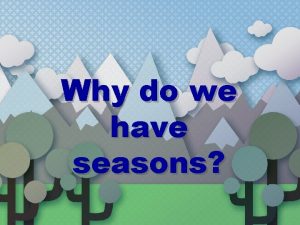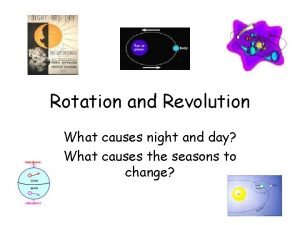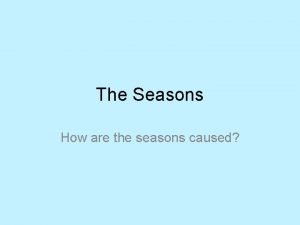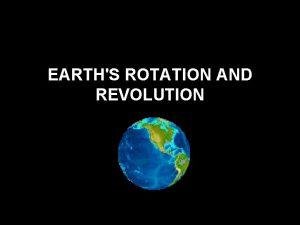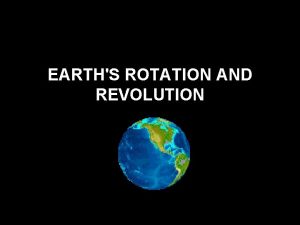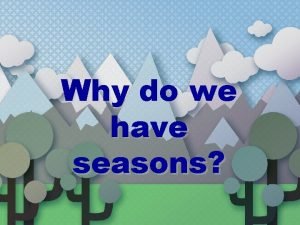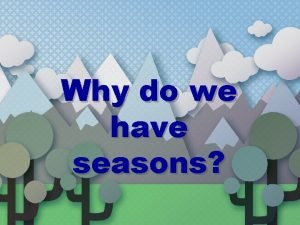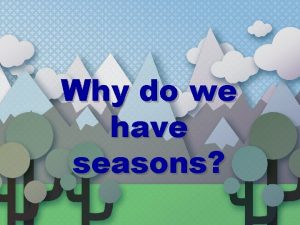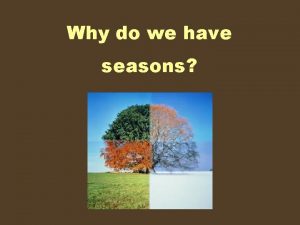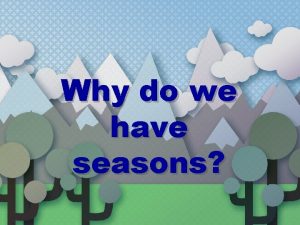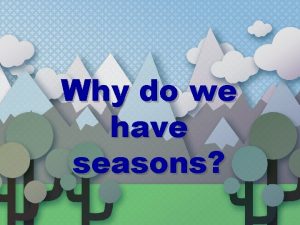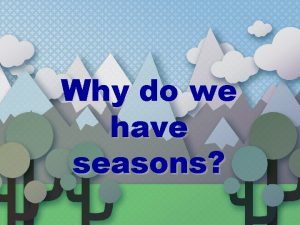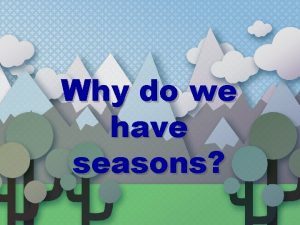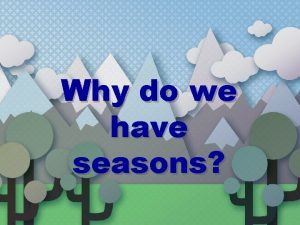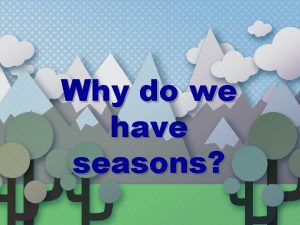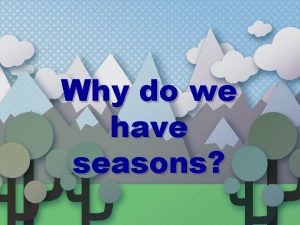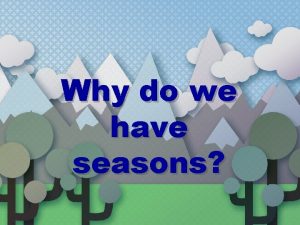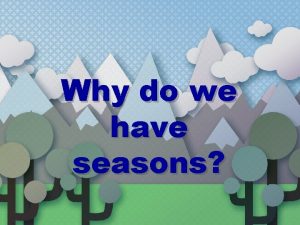Why do we have seasons Earths rotation The





















- Slides: 21

Why do we have seasons?

Earth’s rotation • The Earth rotates on its axis (imaginary vertical line around which Earth spins) every 23 hours & 56 minutes. (24 hours) • The rotational axis is tilted to 23. 5 degrees • The earth revolves around the sun

• The Earth rotates on its axis once every 24 hours. • The direction of rotation direction is counter-clockwise (west to east) if you are viewing Earth from above the North Pole.

Earth’s rotation results in… • • • Day Night Day on Earth is when our side of the Earth faces the sun. • Night on Earth is when the side of Earth we are on faces away from the sun.

Earth’s revolution • The Earth revolves around the Sun once every 365 days (or rotations). This is called a year.

Earth’s Orbit? • The Earth’s orbit around the sun is NOT circle. It is an ellipse. Ellipse

• The least distance between the Earth and Sun is about 147, 000 km and occurs in winter. • The greatest distance between the Earth and Sun is about 152, 000 km and occurs in summer.

Very important!!! • Seasons are not caused by how close the Earth is to the sun. • In fact, the Earth is closest to the sun around January 3 and farthest away from the sun around July 4.

Cause of seasons? • Seasons are the result of the tilt of the Earth's axis. • Earth’s axis is tilted 23. 5°. • This tilting is why we have SEASONS like fall, winter, spring, summer. • The number of daylight hours is greater for the hemisphere, or half of Earth, that is tilted toward the Sun.

Why do we have seasons? • Summer is warmer than winter (in each hemisphere) because the Sun's rays hit the Earth at a more direct angle during summer than during winter

Why do we have seasons? • Also the days are much longer than the nights during the summer. • During the winter, the Sun's rays hit the Earth at an extreme angle, and the days are very short. These effects are due to the tilt of the Earth's axis.

Seasons…in a nut shell

Review Look closely at where the Sun is hitting the Earth during each season: http: //Search. Lycos. com/setup. asp? r=5&src=clear 2&query=weather+savvy

Solstices • Solstices occur twice a year, when the tilt of the Earth's axis is oriented directly towards or away from the Sun, causing the Sun to appear to reach its northernmost and southernmost extremes. • Winter solstice is the shortest day of the year. In the Northern Hemisphere. It occurs on December 21 and marks the beginning of winter. • The Summer Solstice is the longest day of the year. It occurs on June 21 and marks the beginning of summer. Tyrrhenian Sea and Solstice Sky Credit & Copyright: Danilo Pivato

SOLSTICE • During the winter the Northern Hemisphere day lasts fewer than 12 hours and the Southern Hemisphere day lasts more than 12 hours. • During the winter solstice, the North Pole has a 24 -hour night and the South Pole has a 24 -hour day. • Sunlight strikes the earth most directly at the Tropic of Capricorn. http: //k 12. ocs. ou. edu/teachers/ref erence/solstice. gif


Equinoxes • A day lasts 12 hours and a night lasts 12 hours at all latitudes. • Equinox literally means "equal night". • Sunlight strikes the earth most directly at the equator. • This occurs twice a year. http: //k 12. ocs. ou. edu/teachers/reference/e quinox. gif

Equinox • The vernal (spring) equinox occurs March 21. • The autumnal (fall) equinox occurs September 21.

The Earth's seasons are not caused by the differences in the distance from the Sun throughout the year.

The seasons are the result of the tilt of the Earth's axis. I know this is a repeat, but it is important that you understand this idea. Many Americans, including Harvard graduates, do not know what causes seasons!

http: //www. nmm. ac. uk/uploads/gif/seasons-full. gif
 Earths orbit seasons
Earths orbit seasons Why do we have seasons
Why do we have seasons Why do we have seasons
Why do we have seasons What causes seasons rotation or revolution
What causes seasons rotation or revolution There are four seasons all over the world true or false
There are four seasons all over the world true or false Hey hey bye bye
Hey hey bye bye Optical rotation slideshare
Optical rotation slideshare Why do we experience seasons
Why do we experience seasons Whats causes seasons
Whats causes seasons What months are spring
What months are spring Why do we experience seasons
Why do we experience seasons The bluest eye motifs
The bluest eye motifs Earths layers foldable
Earths layers foldable Earths roation
Earths roation Whats a natural satellite
Whats a natural satellite Earths biomes
Earths biomes Most abundant element in earth crust
Most abundant element in earth crust How thick is the earths crust
How thick is the earths crust Whats earths moon called
Whats earths moon called Thickest layer of the earth
Thickest layer of the earth Earths early atmosphere contained
Earths early atmosphere contained The earth layers foldable
The earth layers foldable

